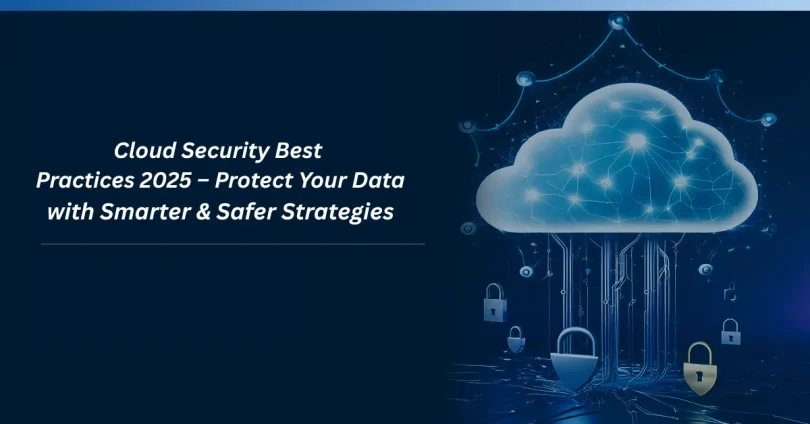Introduction
In today’s digital world, cloud technology is at the heart of how we store, access, and manage data. But as more businesses move to the cloud, the risks of cyber threats and data breaches are also growing fast. That’s why it’s essential to follow the Cloud Security Best Practices 2025 – Protect Your Data with Smarter & Safer Strategies. This guide will help you understand the smartest ways to keep your cloud data secure, avoid common risks, and build a safer digital environment for your business.
What is Cloud Security Best Practices 2025?

Cloud Security Best Practices 2025 are the latest recommended methods and strategies designed to keep cloud-based data, applications, and systems safe from cyber threats. These best practices help businesses protect sensitive information, avoid data breaches, and ensure secure access to cloud resources.
In 2025, these practices include using smarter tools like AI for threat detection, following the Zero Trust model, encrypting data, setting up multi-factor authentication, and regularly monitoring cloud activity. The goal is to stay one step ahead of evolving cyber risks and keep cloud environments protected, reliable, and compliant.
Why Cloud Security Best Practices 2025 Are Important
Protects Sensitive Business Data
- Prevents Data Breaches:
Using strong security practices helps stop hackers from stealing confidential customer and company information. - Maintains Customer Trust:
When data is safe, customers feel confident doing business with you, which strengthens brand reputation. - Reduces Financial Losses:
Avoiding security incidents helps save money on legal fees, fines, and recovery costs from a cyberattack.
Keeps Up with Evolving Cyber Threats
- Defends Against Advanced Attacks:
Modern security threats are smarter, and updated practices help detect and block them faster. - Adapts to New Technologies:
As businesses use AI, IoT, and hybrid clouds, security strategies must evolve to match these changes. - Protects Remote Work Environments:
With more remote teams, cloud access points increase — so strong security is needed at every level.
Ensures Compliance with Laws and Standards
- Meets Regulatory Requirements:
Many industries require cloud data to follow strict rules like GDPR, HIPAA, and ISO standards. - Avoids Legal Trouble:
Proper security helps prevent lawsuits and penalties for mishandling personal or financial data. - Supports Business Audits:
Best practices make it easier to pass compliance checks and keep your systems audit-ready.
Supports Business Continuity
- Prepares for Disasters:
Good security includes backup and recovery plans that help you recover fast after a cyber incident. - Minimizes Downtime:
Strong cloud security keeps your systems running smoothly without unexpected shutdowns or data loss. - Safeguards Critical Operations:
It protects essential apps and services, ensuring your business can serve customers without interruption.
Step-by-Step Guide: Cloud Security Best Practices 2025

Step 1: Assess Your Cloud Security Needs
- Begin by identifying what kind of data and applications you have in the cloud.
- Understand potential risks, regulatory requirements, and business goals related to data protection.
Step 2: Implement a Zero Trust Security Model
- Adopt the “never trust, always verify” approach for all users and devices.
- Limit access strictly to what’s necessary and continuously monitor user behavior.
Step 3: Enable Multi-Factor Authentication (MFA)
- Add an extra layer of protection beyond usernames and passwords.
- Use apps, biometric verification, or SMS codes to confirm identities before access.
Step 4: Encrypt Data at Rest and in Transit
- Ensure that your data is encrypted when it’s stored and when it’s moving between systems.
- Use strong encryption standards (like AES-256) to prevent unauthorized access.
Step 5: Regularly Update and Patch Systems
- Keep your software, applications, and cloud services up to date with the latest patches.
- Automate updates when possible to reduce vulnerabilities and security gaps.
Step 6: Use AI-Powered Threat Detection Tools
- Deploy tools that use artificial intelligence to detect unusual behavior or threats in real time.
- These tools can identify and stop attacks before they cause major damage.
Step 7: Secure APIs and Third-Party Integrations
- Use API gateways and secure tokens for authentication.
- Monitor and control third-party access to avoid weak links in your system.
Step 8: Create a Strong Backup and Disaster Recovery Plan
- Back up your data regularly and store it securely in a separate location.
- Test your recovery process to make sure you can quickly restore operations after an attack or failure.
Step 9: Set Up Role-Based Access Control (RBAC)
- Assign permissions based on job roles to avoid giving unnecessary access.
- Review access rights regularly to remove inactive or outdated users.
Step 10: Conduct Employee Security Training
- Train staff to recognize phishing, social engineering, and unsafe online behavior.
- Keep them updated on new threats and encourage a security-first culture.
Advantages and Disadvantages of Cloud Security Best Practices 2025
| Advantages | Disadvantages |
| Enhanced Data Protection Following best practices like encryption, MFA, and Zero Trust helps protect sensitive business and customer data from cyber threats. | Complex Implementation Process Adopting best practices like Zero Trust and encryption requires technical expertise and careful planning, which can be time-consuming. |
| Faster Threat Detection and Response AI-powered tools and real-time monitoring allow businesses to detect suspicious activity quickly and take immediate action. | Higher Initial Costs Investing in advanced security tools, training, and compliance measures may increase upfront costs for businesses. |
| Improved Compliance and Risk Management Staying aligned with security standards ensures better compliance with laws like GDPR, HIPAA, and ISO, reducing legal and financial risks. | Ongoing Maintenance and Monitoring Security is not a one-time setup. It requires continuous monitoring, regular updates, and periodic audits to remain effective. |
| Business Continuity and Uptime Regular backups and disaster recovery plans help maintain operations and minimize downtime after incidents. | Limited Control in Shared Environments In public or hybrid clouds, part of the responsibility lies with the cloud provider, which can reduce visibility and control for businesses. |
| Increased Customer Trust and Confidence Strong cloud security builds credibility, showing customers that their information is safe and handled responsibly. | Dependency on Third-Party Tools Relying on external security vendors or cloud-native tools introduces potential risks if those services experience failures or breaches. |
Frequently Asked Questions (FAQs)
Q1: What are cloud security best practices in 2025?
They are the latest recommended steps to keep your cloud data and systems safe from hackers, leaks, and cyberattacks.
Q2: Why is cloud security important for businesses?
It protects your customer data, avoids costly security problems, and helps you follow legal rules and industry standards.
Q3: Is public cloud safe to use in 2025?
Yes, public clouds can be very safe if you follow security best practices like encryption, MFA, and regular monitoring.
Q4: What is Zero Trust in cloud security?
Zero Trust means not automatically trusting anyone — even inside your network — and always checking their identity before giving access.
Q5: How can small businesses protect their cloud data?
Start with strong passwords, use multi-factor authentication, back up your data, and train employees on basic security steps.
Q6: What happens if I don’t follow cloud security best practices?
Your data could be stolen or leaked, your business may face legal trouble, and you could lose customer trust.
Q7: How often should I check or update my cloud security?
You should review your cloud security at least once a month, and every time you make big changes to your system or add new tools.
Conclusion
Cloud security is more important than ever in 2025. By following smart and simple practices—like using strong passwords, enabling MFA, and keeping your data encrypted—you can keep your business safe from threats. Stay updated, stay alert, and make cloud security a regular part of your business routine. It’s the key to protecting your data and building trust with your customers.
Bonus Points
- Use Cloud-Native Security Tools
Most cloud providers like AWS, Azure, and Google Cloud offer built-in security tools. Use them to simplify monitoring and threat protection. - Create a Cloud Security Policy
Document your company’s rules for cloud access, data handling, and response to threats. This keeps everyone on the same page. - Perform Regular Penetration Testing
Hire experts to test your cloud setup by simulating attacks. This helps you find and fix weak spots before real hackers do. - Segment Your Cloud Network
Break your cloud infrastructure into smaller, isolated sections. This limits damage if one area is compromised. - Monitor Cloud Costs Alongside Security
Some security features can increase cloud costs. Use cloud cost management tools to balance safety and spending.





